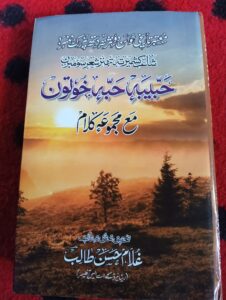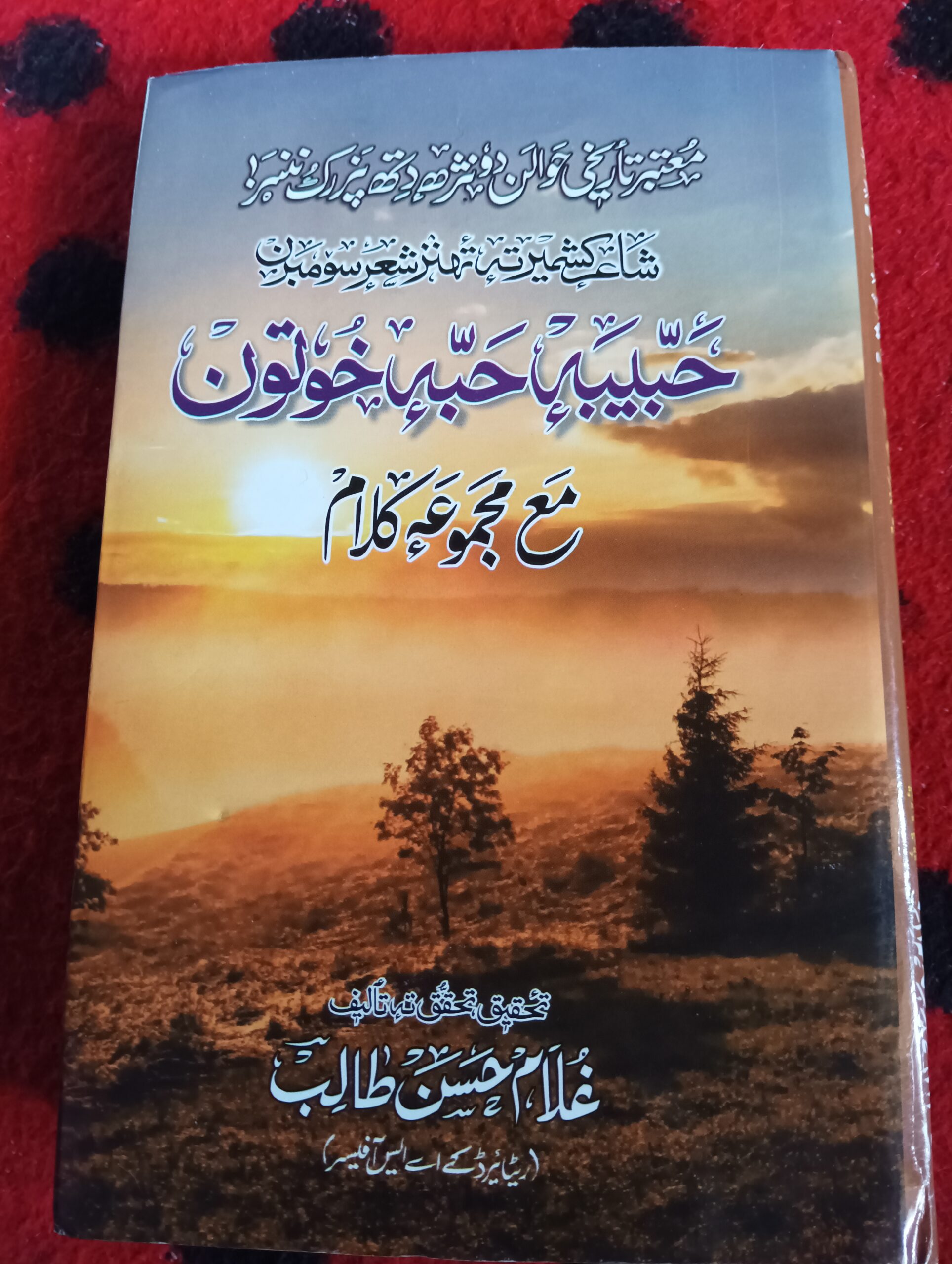Gh Hassan Talib’s latest publication, ‘Habiba Habba Khatoon,’ is a captivating exploration into the life and times of an iconic figure in Kashmiri history. With scholarly precision and heartfelt dedication, Talib resurrects the legacy of Habba Khatoon, weaving a narrative that transcends time.
By Rayees Ahmad Kumar
Gh Hassan Talib, a luminary hailing from the idyllic Newa village in Pulwama district, emerges as a towering figure in the literary landscape with a journey spanning over several decades. Initially, delving into the realm of education, Mr. Talib later transitioned into the esteemed Civil Services, retiring from his tenure in 2002. Among his several literary endeavors, the focus of this review lies on his latest publication, “Habiba Habba Khatoon,” brought forth by Deenu Duniya Kitab Ghar, Newa Pulwama. This opus, extending across 240 pages, boasts of a meticulously crafted cover and employs superior quality paper.
In a poignant dedication, Mr. Talib pays homage to his departed younger sister, whose untimely departure left an indelible mark on his soul. The narrative unfolds with a captivating exploration into Kashmiri historiography. The opening chapter, titled ‘Kashiri Hindi Tawarikhuk Mukhtasar Jayizah’ (5-22), intricately delves into the nuanced perspectives surrounding the historiographical lineage of Kashmir. Challenging conventional notions, Mr. Talib embarks on a scholarly discourse, unraveling the intricate tapestry of historical accounts predating the renowned Rajtarangni by Kalhana. Drawing from a multitude of sources, he navigates through divergent viewpoints, shedding light on the obscured epochs of Kashmir’s past.
Amidst this scholarly odyssey, Mr. Talib meticulously dissects the historiographical landscape, scrutinizing the works of eminent scholars and historians. From the seminal contributions of Pandit Ratnagar to the critical insights offered by Pir Hassan Shah Khoihami, each narrative thread is meticulously woven into the fabric of Kashmir’s historical discourse. Furthermore, he critiques the lacunae prevalent in contemporary historiography, lamenting the biased narratives that often permeate scholarly accounts.
Transitioning seamlessly, the narrative segues into an exploration of Kashmiri language and literature, a domain often overlooked in historical exegesis. Mr. Talib, drawing upon years of scholarly inquiry, unearths the seminal works that illuminate the linguistic and literary heritage of Kashmir. From Abdul Ahad Azad’s seminal treatise to the seminal insights of Naji Munwar and Shafi Shouq, each work serves as a beacon, illuminating the rich tapestry of Kashmiri literary tradition.
Venturing further into the annals of history, Mr. Talib embarks on a genealogical odyssey, tracing the lineage of the enigmatic Habiba Habba Khatoon. With meticulous precision, he unravels the intricate web of familial ties and societal norms that shaped her existence. From her humble origins in Pulwama to her matrimonial alliance with Kamaludin of Srinagar, each revelation adds a layer of depth to her enigmatic persona.
Drawing from a diverse array of historical records and scholarly insights, Mr. Talib presents a compelling narrative that transcends the confines of conventional historiography. Through his magnum opus, “Habiba Habba Khatoon,” he not only resurrects the forgotten voices of Kashmir’s past but also beckons readers to embark on a journey of intellectual inquiry and historical reclamation. In this meticulously crafted narrative, Mr. Talib emerges as a beacon of scholarship, illuminating the hitherto obscured corridors of Kashmir’s rich cultural heritage.

Given Abdi Rather’s humble origins within a peasant family, it is widely speculated that he acted as a devoted disciple, or mureed, of Bahar Shah, dutifully adhering to all directives without hesitation. Thus, he assumed the responsibility of nurturing Habiba. However, due to challenges in pronouncing her name, the locals temporarily dubbed her ‘Zooni’. In the fourth chapter of “The Coming of the Sufi Saint to Kashmir and Syed Sultan Fakhruddin Newa,” Mr. Talib asserts that the Islamic roots of Kashmir trace back to the pivotal moment when Rinchan Shah encountered the devout and God-fearing Syed Ab Rehman Bulbul Shah on the banks of the Jhelum River, embracing Islam under his influence and subsequently renamed Sultan Saddrudin. This marked the beginning of a transformative period with the arrival of Jalaluddin Mukhdoom, followed by Mir Syed Ali Hamadani, revered as the patron Saint of numerous followers. To disseminate the noble teachings among the masses, Mir Syed Ali Hamadani’s nephews, Mir Syed Hussain Simnani and Syed Tajuddin Simnani, journeyed to Kashmir. Drawing from references such as “Gulistan-i-Kashmir” by Prof. Shamsuddin Ahmad, “Waqaati Kashmir” by Khwaja Mohd Azam Dedmari, and “Tazkira Awlia” by Pir Hassan Shah Khoihami, it becomes evident that Syed Sultan Fakhruddin and his brother, Syed Fareedudin, accompanied Mir Syed Hyder Kubrawi to Kashmir during Sultan Sikander’s reign. Sultan Syed Fakhruddin’s mausoleum rests in Newa Charath Pargana, while his brother Syed Fareedudin’s is in Jamalta Srinagar. Historians maintain that Syed Qasim, a disciple and cousin of Sultan Syed Fakhruddin, found his final resting place in Nowbugh. Upon learning of Mir Mohammad Hamadani’s arrival, Sheikh Noordin Noorani exclaimed, “The spiritual mentor and guide of Kashmiris has arrived!”
In the fifth chapter, the narrative delves into Habiba’s, or Habba Khatoon’s, initial marriage. Extensive research indicates that Abdi Rather, her guardian, arranged her marriage into a Syed family with her maternal cousin, Syed Kamaludin. However, the union was short-lived due to Habiba’s passion for poetry and music, which clashed with her in-laws’ expectations, leading to her eventual divorce. In the sixth chapter, the historical significance of Kakpora Village is elucidated. Situated strategically along the Jhelum River, Kakpora emerged as a vital trading hub, boasting efficient water transport via boats. Throughout different periods of rule, from Budshah to Yousuf Shah Chak, Kakpora thrived as a center for education and cultural activities, witnessing the construction of government guesthouses during Yousuf Shah Chak’s reign. However, it also endured the ravages of war, leaving behind ruins and rubble. Chapter seven revisits Habba Khatoon’s life, focusing on her second marriage. Professor Bashar Bashir’s research challenges the notion of Yousuf Shah Chak marrying an ordinary singing lady, suggesting instead that her affluent family background may have influenced his decision. Despite myths suggesting a romantic encounter in saffron fields, the reality of strained relations with her in-laws leading to divorce is emphasized. Accounts by Mohd Din Fouq and other scholars shed light on the dynamics of their relationship, concluding with Yousuf Shah Chak’s death at 50 and Habba Khatoon’s at 55. Chapter eight explores the intertwined realms of kingship and poetry within the couple’s life. Yousuf Shah Chak, renowned not only for his governance but also for his poetry, music, and religious scholarship, emerges as a multifaceted figure.
Historical texts underscore the poetic prowess of both Yousuf Shah Chak and Habba Khatoon, portraying them as individuals deeply connected to the cultural and spiritual fabric of Kashmir. Sultan Ali Chak and Yousuf Shah Chak’s reverence for spiritual figures like Baba Hyder Reshi and Sheikh Hamza Mukhdoom further illustrates their spiritual inclinations. Habba Khatoon’s enduring popularity as a poetess among rural women highlights her profound impact on Kashmiri literature. Chapter nine unravels the mystery surrounding Habba Khatoon’s final resting place. Conflicting accounts suggest her burial at Athwajan, Panthachowk, or Bihar, reflecting the complexities of historical narratives. Various scholars and literary figures offer differing perspectives, yet all attest to her enduring legacy and contribution to Kashmiri culture. In conclusion, the narrative offers a comprehensive exploration of Habba Khatoon’s life, from her upbringing in Newa to her marriages, poetic legacy, and final resting place, inviting readers to rediscover this iconic figure in Kashmiri history.
The views expressed in this article are solely those of the author and do not necessarily reflect the opinions or views of this Magazine. The author can be reached at [email protected]

Leave a Reply